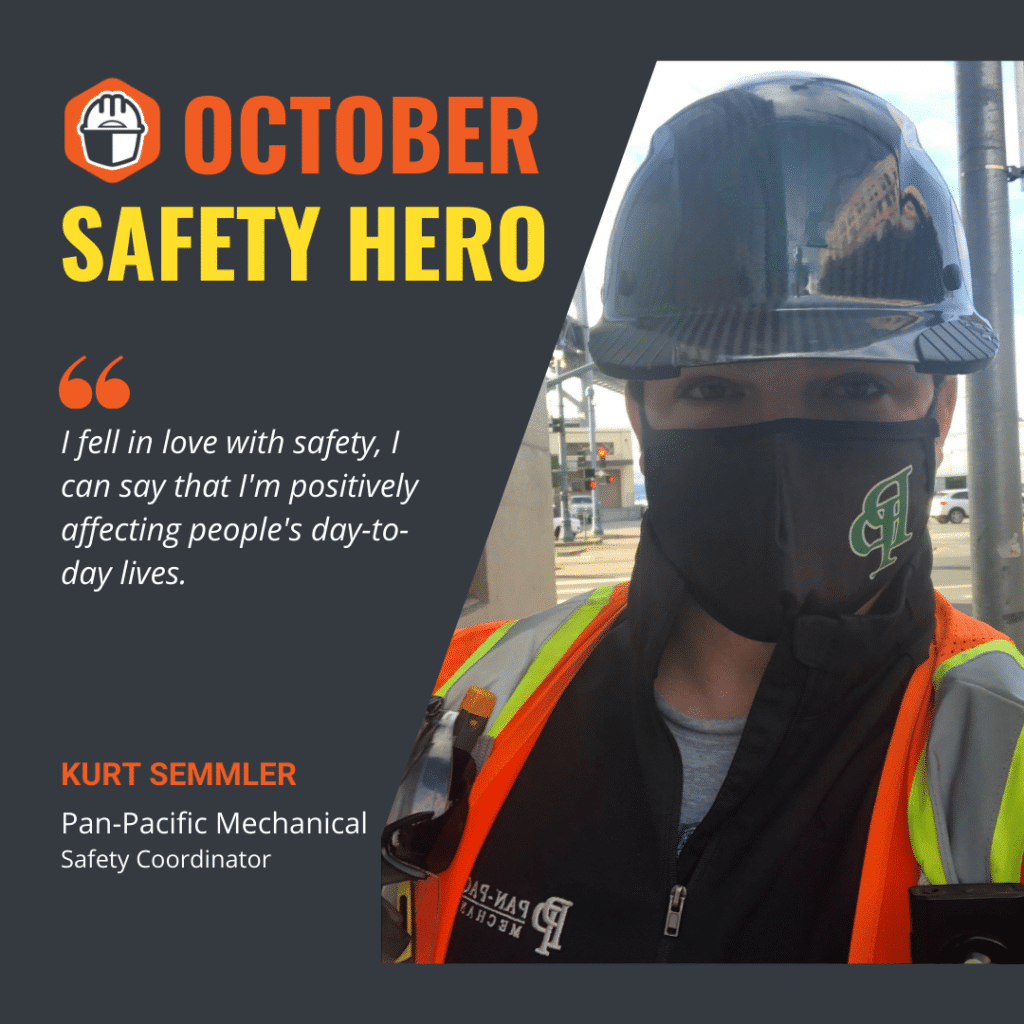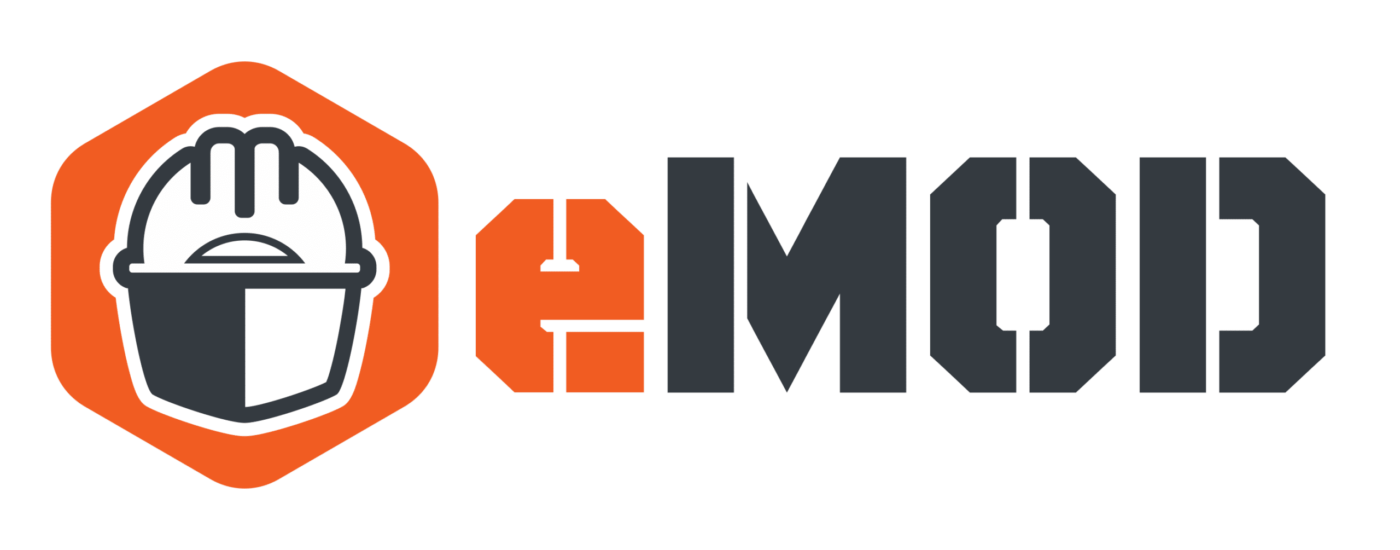
By Hannah Aguilar-Mota
Five years ago, Kurt Semmler was working in theatre in New York City. He liked it (as a side job, he was also managing a wine bar), but felt unfulfilled. He wanted to have more of a positive impact on people’s lives than the 2-3 hours of entertainment a show might offer.
So, when a friend told him the construction industry, one of the world’s most dangerous professions, was in need of safety professionals, he was intrigued. He took an OSHA training course, was almost immediately hired into an entry-level construction safety position, and his new career was hatched.
“I fell in love with [safety],” the 30-year-old safety coordinator for Pan-Pacific Mechanical told me recently. “It was everything I wanted and more. I was looking for something that would be fulfilling. And now I can say that I’m positively affecting people’s day-to-day lives.”
Kurt has been named October’s eMOD Construction Safety Hero, nominated for his diligent safety work by Dome Construction safety officer Chris Reynoso. “Kurt is a big part of the Pan Pacific success on our job sites,” Chris said, “from engaging with eMOD, to ensuring all of his employees are trained and compliant with certifications, fall protection training, powder actuated tools, and more.”
I recently had the chance to talk with Kurt about his somewhat unusual career journey, and his views about construction safety.
What did you do before construction?
My original background was actually in the theater. I did that in New York for about five years while also managing a wine bar for about three years. I kind of fell out of love with doing theater and wanted something more significant, and a good friend of mine had made a move into the construction industry. And he suggested completing the OSHA 30 safety course. I really didn’t know anything about construction or safety, but I knew that it could be a good stepping stone to get into an entry-level role. Right after I finished OSHA 30, a company needed to find somebody in an entry-level position to basically watch one particular job site because of an incident that had just occurred. So I kind of just got thrown into it — and then I fell in love with it. It was everything I wanted and more. I was looking for something that would be fulfilling. And now I can say that I’m positively affecting people’s day-to-day lives.
What was it about safety in construction that appealed to you?
My biggest problem with the theater was that I stopped feeling as though I was affecting the world positively. It’s entertaining, sure. OK, yeah, we’re putting on a show. But at the end of the day, the audience goes back home to the same problems they had before.
With construction safety, it immediately sparked in me that I can actually be protecting people. And all the guys and gals in the field — and even in the office — they’ve all become just a big family to me. So, yeah, that’s what it’s all about for me — affecting people positively on a regular basis.
Is there anything you learned from the theater that somehow prepared you for construction?
Communication. That’s key. Being able to be personable and openly communicate is something not many people do really well. Because I have that experience in speaking publicly I’m able to effectively communicate what I need people to understand — and to help educate. And that came from my background in theater.
What does your typical day look like as a safety coordinator?
Most of the time I work in the field. I try not to be in the office unless it’s absolutely necessary. Safety inspections are my primary focus — along with education and training.
What are some of the biggest hazards that you see in your day-to-day work?
Fall hazards for sure. I have zero tolerance for somebody who is putting themselves or others at risk. Something as simple as a two- or three-foot fall could end somebody’s life or permanently injure them. I think people take it for granted.
How do you explain to your crew why safety is important?
That’s easy — it’s family. You know, not many people have to work in dangerous situations as we have in the construction industry. So I try to explain to them that, “Your wife and your kids — they expect you to come home. They may not understand the risks involved in what we do on a day-to-day basis. But they expect you to come home intact and in the exact same condition that you left in the morning.”
Have you ever witnessed a serious injury on the job site?
Well, it was more of a near miss, but the worker was traumatized by it. A mark-out was misplaced on the ground. And we were jackhammering to break apart some concrete. Due to someone else’s negligence, they actually hit live electrical and, ”Pop!” Luckily, the individual wasn’t hurt, but he was scared to death. He didn’t have all the proper PPE on — so that was certainly a wake-up moment for him. He didn’t feel comfortable for months using a jackhammer again.
How did that affect you?
It’s scary. You think about all the steps they should have taken. If they had missed one more of them, that individual may not be with us today. And I think about what would have happened if I had to call his wife, let her know that her husband was in a workplace incident and he’s at the hospital. I think anytime something like that happens, you try to learn from it, but it sticks in your head. It can affect you personally.
Chris at Dome Construction said you were an important part of the success and safety at a recent job site. How does it feel to get that kind of positive feedback?
It feels awesome. I appreciate that my efforts in the field are noticed. But to me, that’s just a day in the life — what we’re expected to do. And it’s all about trying to be proactive, not reactive.
Chris and I have a good relationship. As far as that goes, I try to communicate all of the hazards that we have onsite — and things that are coming up in the future. I’m really fortunate to have a very strong group of general contractors, foremen, and superintendents.
What do you see as the biggest challenge when it comes to safety in the industry?
The biggest challenge is slowing down and thinking about what we’re actually doing. The work, even in the four years I’ve been here, just seems to get faster and faster and faster. And I always tell the crew that it’s much better to take a step back, breathe, and think about what you’re actually doing than it is to just keep pushing, pushing, pushing. God only knows what could happen if you’re not paying attention to what you’re doing. And I tell them, “If you rush and there is an incident, all work is going to be stopping, right?”
So, preplanning is key. Take a breath. Slow down. Look at your surroundings. Check out your hazards. Fill out your paperwork properly including every risk that you can think of.
Have you seen any big changes in safety practices since you started in the industry?
There’s a lot more involvement of safety officers in the field. It’s not just safety guys sitting in the office, but actually being involved on the job site.
How do you like using eMOD?
I like how everything related to safety is centrally located — and you can just pull up everything from one location. Often, on a lot of our other job sites, all the different trades have their own way of doing things. Some are using paper copies. Some are using different apps. Some are doing inspections on some other platform. And it’s nice to have one central hub. It’s transparent, too. You can see what every trade is doing on a job site, which is very cool.
How have your personal views on safety changed since you started four years ago?
At first, I was a little unsure of what my involvement was going to be. I viewed myself as safety.
You guys are in the field. You’re the foreman. Everyone is in separate departments. And now it’s not that way at all. We’re all just human beings — all on-site — and we need to look out for each other. And safety is everybody’s job. I try to empower my crews. I’m here to support you. I’m here to educate. But others may see things that I don’t see. Every person on a site is part of a network, a group of people, human beings, a family.
What does it mean to be honored as a safety hero?
It feels good! It means I’m doing what I’m supposed to do and that my crew is doing what they’re supposed to do. And that they’re reaching out to me and getting me involved so that I can aid and assist them to make the project run more smoothly. Because I tell you what, it’s a lot easier to have a discussion about a hazard and get in front of it than it is to find out about it when it becomes a bigger problem later.
Last question. What is your favorite part of the job?
The camaraderie. That is my favorite part. I just like when my crew members call me, whether it’s good news or bad news. I enjoy talking through problems and working through them. It’s not just me telling them what to do. It’s an open conversation. We’re all just trying to get everybody home safely.
Thanks for your time Kurt — and congratulations!
What is the eMOD Safety Hero Award?
Once a month, eMOD highlights someone working in the commercial construction industry who practices their craft with a safety-first approach. We recognize heroes who put safety ahead of productivity, who take action today to make our work safer tomorrow, who do the right thing rather than the most convenient. They promote accountability among team members, champion the latest safety practices, and encourage transparency about hazardous situations as they arise.

